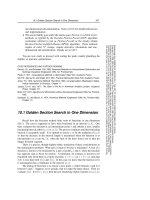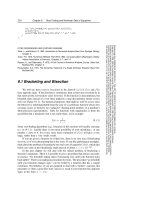CRC Press - Mechanical Engineering Handbook- Mechanics Of Solids Part 2 docx
Bạn đang xem bản rút gọn của tài liệu. Xem và tải ngay bản đầy đủ của tài liệu tại đây (30.69 KB, 1 trang )
1-10 Section 1
Example 2
The torque wrench in Figure 1.2.10 has an arm of constant length L but a variable socket length d =
OA because of interchangeable tool sizes. Determine how the moment applied at point O depends on
the length d for a constant force F from the hand.
Solution. Using M
O
= r × F with r = Li + dj and F = Fk in Figure 1.2.10,
Judgment of the Result
According to a visual analysis the wrench should turn clockwise, so the –j component of the moment
is justified. Looking at the wrench from the positive x direction, point A has a tendency to rotate
counterclockwise. Thus, the i component is correct using the right-hand rule.
Equilibrium of Rigid Bodies
The concept of equilibrium is used for determining unknown forces and moments of forces that act on
or within a rigid body or system of rigid bodies. The equations of equilibrium are the most useful
equations in the area of statics, and they are also important in dynamics and mechanics of materials.
The drawing of appropriate free-body diagrams is essential for the application of these equations.
Conditions of Equilibrium
A rigid body is in static equilibrium when the equivalent force-couple system of the external forces
acting on it is zero. In vector notation, this condition is expressed as
(1.2.13)
where O is an arbitrary point of reference.
In practice it is often most convenient to write Equation 1.2.13 in terms of rectangular scalar com-
ponents,
FIGURE 1.2.10Model of a torque wrench.
Mijkij
O
LdFFdFL=+
()
×=−
F
MrF
∑
∑∑
=
=×
()
=
0
0
O
FM
FM
FM
xx
yy
zz
∑∑
∑∑
∑∑
==
==
==
00
00
00









